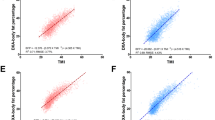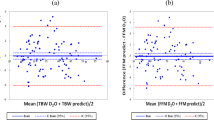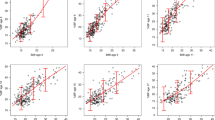Abstract
OBJECTIVE: To compare estimates of fat mass (FM), fat-free mass (FFM) and percentage body fat (%fat) by six different methods in prepubertal girls.
DESIGN: Cross-sectional study.
SUBJECTS: Normal-weight, multi-ethnic, prepubertal girls (age=8.5±0.4 y, n=101).
MEASUREMENTS: Body composition was measured in each child by anthropometry (skinfold thickness using Slaughter equation), dual-energy X-ray absorptiometry (DXA), total body potassium (TBK), isotope dilution for total body water measurement (TBW), multifrequency bioelectrical impedance spectroscopy (BIS), and total body electrical conductivity (TOBEC).
RESULTS: TOBEC and skinfold thickness yielded the lowest values of FM followed by DXA, TBK, TBW and BIS, with BIS giving the highest value of FM. All methods were significantly different for FFM, FM and %fat (P<0.001), except FFM by DXA and TBK. The Bland–Altman limits of agreement among the methods reveal that they are not directly interchangeable for FM, FFM, or %fat. The largest mean difference for FM was between TOBEC and BIS (−2.90 kg), whereas the smallest mean difference was between TOBEC and skinfold thickness (−0.14 kg). For FFM, the largest mean difference was also between TOBEC and BIS (2.83 kg), but the smallest mean difference for FFM was between DXA and TBK (−0.03 kg). For %fat, the mean differences were larger, −10.5% for TOBEC and BIS and+9.7% for skinfold thickness and BIS. The closest two techniques for %fat were TOBEC and skinfold thickness (mean difference of −0.62%) and DXA and TBK (−1.81%).
CONCLUSIONS: We found that estimates of body composition in prepubertal 8-y-old girls are highly method-dependent and that the six methods studied (DXA, TBK, TBW, TOBEC, BIS and anthropometry) are not directly interchangeable.
This is a preview of subscription content, access via your institution
Access options
Subscribe to this journal
Receive 12 print issues and online access
$259.00 per year
only $21.58 per issue
Buy this article
- Purchase on Springer Link
- Instant access to full article PDF
Prices may be subject to local taxes which are calculated during checkout



Similar content being viewed by others
References
Ellis KJ, Shypailo RJ, Pratt JA, Pond WG . Accuracy of dual-energy X-ray absorptiometry for body-composition measurements in children Am J Clin Nutr 1994 60: 660–665.
Pintauro SJ, Nagy TR, Duthie CM, Goran MI . Cross-calibration of fat and lean measurements by dual-energy X-ray absorptimetry to pig carcass analysis in the pediatric body weight range Am J Clin Nutr 1996 63: 293–298.
Figueroa-Colon R, Mayo MS, Treuth MS, Aldridge RA, Weinsier RL . Reproducibility of dual-energy X-ray absorptiometry measurements in prepubertal girls Obes Res 1998 6: 262–267.
Troiano RP, Flegal KM, Kuczmarski RJ, Campbell SM, Johnson CL . Overweight prevalence and trends for children and adolescents: the National Health and Nutrition Examination Surveys, 1963 to 1991 Arch Pediatr Adolesc Med 1995 149: 1085–1091.
Ellis KJ . Measuring body fatness in children and young adults: comparison of bioelectrical impedance analysis, total body electrical conductivity, and dual-energy X-ray absorptiometry Int J Obes Relat Metab Disord 1996 20: 866–873.
Goran MI, Driscoll P, Johnson R, Nagy TR, Hunter G . Cross-calibration of body-composition techniques against dual-energy X-ray absorptiometry in young children Am J Clin Nutr 1996 63: 299–305.
Gutin B, Litaker M, Islam S, Manos T, Smith C, Treiber F . Body-composition measurement in 9–11-y-old children by dual-energy X-ray absorptiometry, skinfold-thickness measurements, and bioimepedance analysis Am J Clin Nutr 1996 63: 287–292.
Roemmich J, Clark PA, Weltman A, Rogol AD . Alterations in growth and body composition during puberty. I. Comparing multicompartment body composition models. J Appl Physiol 1997 83: 927–935.
Wells JC, Fuller NJ, Dewit O, Fewtrell MS, Elia M, Cole TJ . Four-component model of body composition in children: density and hydration of fat-free mass and comparison with simpler models Am J Clin Nutr 1999 69: 904–912.
Okasora K, Takaya R, Tokuda M, Fukunaga Y, Oguni T, Tanaka H, Konishi K, Tamai H . Comparison of bioelectrical impedance analysis and dual energy X-ray absorptiometry for assessment of body composition in children Pediatr Int 1999 41: 121–125.
Heymsfield SB, Lichtman S, Baumgartner RN, Wang J, Kamen Y, Aliprantis A, Pierson RN . Body composition of humans: comparison of two improved four-component models that differ in expense, technical complexity, and radiation exposure Am J Clin Nutr 1990 52: 52–58.
Wellens R, Chumlea WC, Guo S, Roche AF, Reo NV, Siervogel RM . Body composition in white adults by dual-energy X-ray absorptiometry, densitometry, and total body water Am J Clin Nutr 1994 59: 547–555.
Slaughter MH, Lohman TG, Boileau RA, Horswill CA, Stillman RJ, Van Loan MD, Bemben DA . Skinfold equations for estimation of body fatness in children and youth Hum Biol 1988 60: 709–723.
De Lorenzo A, Andreoli A, Matthie J, Withers P . Predicting body cell mass with bioimpedance by using theoretical methods: a technological review J Appl Physiol 1997 85: 1542–1558.
Ellis KJ, Shypailo RJ . Whole-body potassium measurements independent of body size Basic Life Sci 1993 60: 371–375.
Moore FD, Olesen KH, McMurrey JD, Parker HV, Ball MR, Boyden CM . The body cell mass and its supporting environment WB Saunders: Philadelphia, PA 1963 21–23.
Forbes GB . Human body composition: growth, aging, nutrition and activity Springer: New York 1987 169–195.
Fomon SJ, Haschke F, Ziegler EE, Nelson SE . Body composition of reference children from birth to age 10 y Am J Clin Nutr 1982 35: 1169–1175.
Prentice AM (ed) . A consensus report by the International Dietary Energy Consultancy Working Group. The doubly labeled water method for measuring energy expenditure International Atomic Energy Agency: Vienna 1990.
Treuth MS, Butte NF, Wong WW . Effects of familial predisposition to obesity on energy expenditure in multiethnic, prepubertal girls Am J Clin Nutr 2000 71: 893–900.
Bland JM, Altman DG . Statistical methods for assessing agreement between two methods of clinical measurement Lancet 1986 i: 307–310.
Fuller NJ, Jebb SA, Laskey MA, Coward WA, Elia M . Four-component model for the assessment of body composition in humans: comparison with alternative methods, and evaluation of the density and hydration of fat-free mass Clin Sci 1992 82: 687–693.
Pierson RN, Wang J, Heymsfield SB, Russell-Aulet M, Mazariegos M, Tierney M, Smith R, Thornton JC, Kehayias J, Weber DA, Dilmanian FA . Measuring body fat: calibrating the rulers. Intermethod comparison in 389 normal Caucasian subjects Am J Physiol 1991 261: E103–E108.
Tothill P, Avenell A, Love J, Reid DM . Comparisons between hologic, lunar and norland dual-energy X-ray absorptiometers and other techniques used for whole body soft tissue measurements Eur J Clin Nutr 1994 48: 781–794.
Tataranni PA, Pettitt DJ, Ravussin E . Dual energy X-ray absorptiometry: inter-machine variability Int J Obes Relat Metab Disord 1996 20: 1048–1050.
Acknowledgements
We would like to thank the children who participated in the study; the MRU staff and body composition staff for technical assistance; and B Kertz for subject recruitment. This study was supported by NIH R29 HD34029 (M Treuth) and USDA Agricultural Research Service Cooperative Agreement 6250-51000-023-00D/01 (M Treuth, N Butte, W Wong, K Ellis).
Author information
Authors and Affiliations
Corresponding author
Additional information
The contents of this publication do not necessarily reflect the views or policies of the US Department of Agriculture, nor does mention of trade names, commercial products or organizations imply endorsement by the US Government.
Rights and permissions
About this article
Cite this article
Treuth, M., Butte, N., Wong, W. et al. Body composition in prepubertal girls: comparison of six methods. Int J Obes 25, 1352–1359 (2001). https://doi.org/10.1038/sj.ijo.0801731
Received:
Revised:
Accepted:
Published:
Issue Date:
DOI: https://doi.org/10.1038/sj.ijo.0801731
Keywords
This article is cited by
-
Equations based on anthropometric measurements for adipose tissue, body fat, or body density prediction in children and adolescents: a scoping review
Eating and Weight Disorders - Studies on Anorexia, Bulimia and Obesity (2022)
-
Percentile reference values for anthropometric body composition indices in European children from the IDEFICS study
International Journal of Obesity (2014)
-
Relative Hypoadiponectinemia, Insulin Resistance, and Increased Visceral Fat in Euthyroid Prepubertal Girls With Low-Normal Serum Free Thyroxine
Obesity (2012)
-
Pediatric body composition analysis with dual-energy X-ray absorptiometry
Pediatric Radiology (2009)
-
Comparison of body fatness measurements by BMI and skinfolds vs dual energy X-ray absorptiometry and their relation to cardiovascular risk factors in adolescents
International Journal of Obesity (2005)



